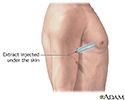Lepromin skin test
Leprosy skin test; Hansen disease - skin test
The lepromin skin test is used to determine what type of leprosy a person has.
How the Test is Performed
A sample of inactive (cannot cause infection) leprosy-causing bacteria is injected just under the skin, often on the forearm, so that a small lump pushes the skin up. The lump indicates that the antigen has been injected at the correct depth.
The injection site is labeled and examined 3 days, and again 28 days later to see if there is a reaction.
How to Prepare for the Test
People with dermatitis or other skin irritations should have the test performed on an unaffected part of the body.
If your child is to have this test performed, it may be helpful to explain how the test will feel, and even demonstrate on a doll. Explain the reason for the test. Knowing the "how and why" may reduce the anxiety your child feels.
How the Test will Feel
When the antigen is injected, there may be a slight stinging or burning. There may also be mild itching at the site of injection afterward.
Why the Test is Performed
Leprosy is a long-term (chronic) and potentially disfiguring infection if left untreated. It is caused by Mycobacterium leprae bacteria.
This test is a research tool that helps classify the different types of leprosy. It is not recommended as the main method to diagnose leprosy.
Normal Results
People who don't have leprosy will have little or no skin reaction to the antigen. People with a particular type of leprosy, called lepromatous leprosy, will also have no skin reaction to the antigen.
What Abnormal Results Mean
A positive skin reaction may be seen in people with specific forms of leprosy, such as tuberculoid and borderline tuberculoid leprosy. People with lepromatous leprosy will not have a positive skin reaction.
Risks
There is a very small risk for an allergic reaction, which may include itching and rarely, hives.
References
Dupnik K. Leprosy (Mycobacterium leprae). In: Bennett JE, Dolin R, Blaser MJ, eds. Mandell, Douglas, and Bennett's Principles and Practice of Infectious Diseases. 9th ed. Philadelphia, PA: Elsevier; 2020:chap 250.
James WD, Elston DM, Treat JR, Rosenbach MA, Neuhaus IM. Hansen disease. In: James WD, Elston DM, Treat JR, Rosenbach MA, Neuhaus IM, eds. Andrews' Diseases of the Skin. 13th ed. Philadelphia, PA: Elsevier; 2020:chap 17.
Review Date: 8/26/2023
Reviewed By: Jatin M. Vyas, MD, PhD, Associate Professor in Medicine, Harvard Medical School; Associate in Medicine, Division of Infectious Disease, Department of Medicine, Massachusetts General Hospital, Boston, MA. Also reviewed by David C. Dugdale, MD, Medical Director, Brenda Conaway, Editorial Director, and the A.D.A.M. Editorial team.






